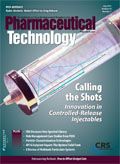Regenerative Medicine: The Need for a National Strategy
US support of regenerative medicine is essential for maintaining a lead on healthcare innovation.
Regenerative medicine provides an ideal opportunity for public investment in an industry that will help the United States maintain its global technological leadership and facilitate needed advances in healthcare. The industry is revolutionizing treatments of numerous chronic diseases, including diabetes, Parkinson's disease, ALS, heart failure, and different types of cancers, by focusing on using living cells to repair tissue and treat the underlying causes of disease. The potential of regenerative medicine to lead to disease-altering treatments for these conditions is real and, in some cases, may include the complete regeneration of damaged tissue and organs.

(DORLING KINDERSLEY/GETTY IMAGES)
Although full-organ replacement technology is likely decades away, dozens of innovative, entrepreneurial firms are advancing therapies in clinical trials for the treatment of costly diseases, such as critical limb ischemia, myocardial infarction, and spinal-cord injury, to name a few. Not only do these therapies represent an opportunity to drastically improve the current standard of care, but they may also provide billions of dollars in long-term cost savings for treatments of these chronic diseases. The potential savings from regenerative medicine treatments for the US alone in terms of the direct costs associated with five prevalent chronic diseases—late-stage Parkinson's disease, new cases of spinal-cord injury, heart failure, stroke, and insulin-dependent diabetes—is approximately $250 billion a year.
Global support
Other nations have also recognized the potential of regenerative medicine and are keen to grow their capabilities in this field. China's Ministry of Science and Technology, for example, allocated more than $290 million dollars for stem-cell research during the period 2006–2010. More than 75% of those funds are being used for product development. The government has prioritized stem-cell and regenerative-medicine research by placing approximately 300 researchers in 30 institutions to focus on key strategic areas, including nerve injury and functional reconstruction of tissue. Japan, the United Kingdom, and Australia have national efforts targeting regenerative medicine and cell therapy priority areas in medical innovation as well.
US strength
Although international investment in regenerative medicine is intensifying, many research institutions and companies leading the efforts to develop new therapies are based in the US. The infrastructure required to manage these programs is significant and contributes to job growth and investment that supports many regional economies. California has led the charge with the creation of the California Institute of Regenerative Medicine (CIRM) through a statewide ballot measure that provided $3 billion in funding for stem-cell research at California universities, research institutions, and therapeutic development companies. CIRM recently released economic impact data estimating that its first $1.1 billion in grants will create 25,000 jobs and $200 million in new tax revenue for California through 2014.
Despite the promise of regenerative medicine in economic development and for improving the healthcare system, companies in this sector still face numerous challenges that are hindering their ability to develop products for patients. These obstacles include insufficient funding for product development and clinical trials, an unclear regulatory pathway for new technologies, inconsistent reimbursement policies, and a general lack of awareness of the potential for regenerative medicine to help us address long-term healthcare costs. Although $4 billion has poured into this growing sector in the US, only 10% of those funds have come from public sources, according to a 2006 report from the US Department of Health and Human Services. The department recognized the need for increased public investment and called for the creation of a Federal Initiative for Regenerative Medicine, similar to the semiconductor manufacturing technology (SEMATECH) public-private consortium model that accelerated the growth of the semiconductor industry in the 1980s and 1990s (1).
National strategy
As the Obama administration touts its innovation strategy as a tool for promoting economic growth, the industry is also recognizing the need for a national strategy for regenerative medicine to sustain investment in this sector and raise the profile of regenerative medicine as one of America's fastest growing innovative industries. The Alliance for Regenerative Medicine has drafted a strategy that is supported by industry to rival bold initiatives that have been announced by China and other countries. The essential elements of the national strategy include:
- Creation of a coordinated plan among the various federal agencies overseeing regenerative-medicine programs and policies
- Development of incentives that will stimulate greater private investment in regenerative medicine technologies and therapies
- Increased federal funding for regenerative-medicine research with a particular emphasis on promoting public–private partnerships
- A predictable regulatory review and approval process
- A reimbursement framework that will help companies plan for and communicate the commercial potential of their products.
The Alliance developed this plan to provide a strategic framework that will complement the legislative proposals included in the Regenerative Medicine Promotion Act of 2011, which the US House of Representatives introduced as H.R. 1862 in May 2011. This legislation calls for the creation of a Regenerative Medicine Coordinating Council among federal government stakeholders, establishment of different funding mechanisms for public–private research projects and preclinical work needed to file an investigatational new drug apppplication, and increased funding for regulatory science research at FDA. The Regenerative Medicine Promotion Act of 2011—along with the national strategy—are essential to US efforts to maintain international leadership in healthcare innovation.
Elizabeth West is director of programs at the Alliance for Regenerative Medicine, ewest@alliancerm.org.
Reference
1. HHS, "Future of Regenerative Medicine," (HHS, 2006), www.hhs.gov/reference/newfuture.shtml.

FDA Approves Novartis Oral Treatment for Adults with C3 Glomerulopathy
March 25th 2025Fabhalta (iptacopan) received a positive opinion for treatment of C3G from the Committee for Medicinal Products for Human Use (CHMP) of the European Medicines Agency (EMA) and has been approved twice before by FDA.